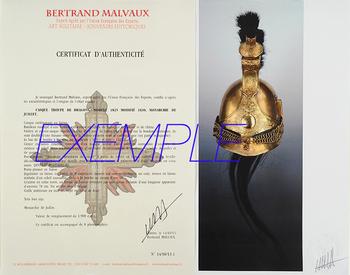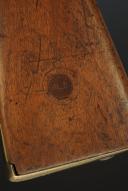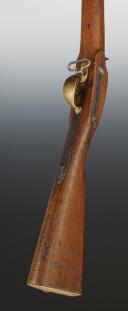
SHOPPING CARBINE, model 1837, called small rifle or Poncharra rifle, July Monarchy. 26764R
Sold out
INFANTRY TIRAILLEUR CARBINE, model 1837, also known as small carbine or carbine à la Poncharra, July Monarchy. 26764R
Eight-sided barrel (length 92 cm, with the breech 98.2 cm) dated "1838", numbered "512", "MR", CALIBER "Cde 17.5", bearing inspection stamps "*P*", "*C*". Breech engraved with "150m". Percussion lock plate known as "à la Pontcharra" marked "Mre Rle de Chatellerault". All brass fittings fixed to the stock with steel springs. Walnut stock numbered "512" on the butt, marked "PLD" (state property) upon reassignment to the National Guard, faintly legible inspection stamp marked "MR". Iron ramrod with nail-shaped head.
Total length 1.35 m.
France.
July Monarchy.
Good condition, usual oxidation on steel parts to clean, showing scratches, some minor dents on wood, rod shortened (41 cm).
Disclaimer requested by Google search ranking service:
This weapon is an antique collectible and cannot be fired; it is inactive, and modern cartridges are not compatible with this non-functioning weapon.
The law of March 6, 2012, categorizes firearms into 4 categories and regulates their acquisition and possession. Proper classification is crucial. Decree No. 2013-700 of July 30, 2013, details the list of firearms belonging to each category.
The presented weapon falls under category D2 with unrestricted ownership, as it is inactive.
END OF A LEGEND "PDL" THE STAMP ON NATIONAL GUARD WEAPONS
Extensive research has failed to locate any evidence of the existence of the motto "For the Right". So what is it all about? What is the National Guard? The National Guard was established during the French Revolution as a militia tasked with maintaining order and upholding the law during troubled times. It consisted of all citizens aged 20 to 60, categorized for service either in reserve or active duty. Initially, the National Guards were predominantly bourgeois, as they were required to bear their own expenses for equipment, including owning a horse for cavalry service. For the bourgeoisie, this role represented a means of maintaining a form of power and distinction from other citizens. The National Guards were stationed in all municipalities and acted as a policing force under the command of officers, the mayor, and the prefect. Under the Empire, the National Guard sometimes served as a reserve army, mobilized for Napoleon's wars. After Charles X dissolved the National Guards in 1827, Louis Philippe reestablished them in 1830. A company was formed in each municipality, consisting of infantry, artillery, cavalry, and firefighters units. The National Guard was reactivated to quell disturbances and restore calm throughout France post-July Revolution.
Marking of weapons with "PDL" in 1831
By late 1830, the minister aimed to bring order to the National Guards, organizing the troops and ordering the retrieval and inventory of weapons distributed during the July Revolution. A document from the Lyon city archives dated August 10, 1830, attests to this. In January 1831, a ministerial circular mandated the marking of weapons distributed by the War Ministry, denoting state ownership with the stamp "PDL," as supported by an official document dated January 20, 1831, preserved in the Lyon archives. This stamping was carried out using a punch traveling from village to village within each canton. The mayor and commanders would oversee the stamping in the presence of assembled National Guards. The punch would remain the property of the main canton town, allowing for further markings in the future. A report would be issued, signed by the mayor, and sent to the prefecture. It is noted that weapons owned by municipalities or purchased by National Guards themselves were exempt from this stamping procedure. The armament of National Guards was quite diverse, encompassing rifles, sabers, cartridge boxes, and other military gear and uniforms, often privately manufactured and differing from standard models. These were acquired by National Guards or municipalities, in addition to the regulation weapons provided to municipalities by the War Ministry. It was only this latter category of state-owned equipment that the ministry sought to mark to assert its ownership and prevent dispersal. An excerpt from the January 1831 circular reproduced the printed notice accompanying the punch destined for municipalities, detailing the stamping process for rifles. The same circular announced the publication, with the Interior Ministry's approval, of an arms manual for the National Guards.
In 1848, following the February Revolution and the advent of the Second Republic, a decree in March reactivated the National Guard. A front-page excerpt from the October 29, 1848, "Courrier de la Drôme et de l'Ardèche" No. 224 demonstrates that the same measures as in 1831 (an ongoing law) were enforced, including the inventorying of National Guards and their weapons. The marking of government weapons with "PDL" was reaffirmed. It was also forbidden for private gunsmiths to convert National Guard arms to percussion, aiming to prevent the proliferation of available calibers.
The "PLD" stamp
The mark on the wood, created by stamping a blackened metal imprint with the letters PDL, has long been misconstrued as the motto "For the Right," with no substantiated basis. These documents clarify that it merely denotes "Propriété De L'état" (Property of the State). The rooster symbol at the top, revived by Louis Philippe upon ascending to power in 1831, reflects a national emblem found on the stocks of pistols and standard rifles used by the National Guard. These were typically models 1816 or 1822 pistols and often 1777 corrected An IX rifles. The War Ministry supplied the National Guards with outdated weapons, reserving the newer 1822 models for military use, followed by the 1822 T and Tbis models.
Evolution of the PDL marking
Further examination of military archives has revealed additional variations of this state identification mark, sometimes visible on edged weapons like swords or bayonets.
[Link to a PDF document detailing the PDL stamp on white arms.]
Eight-sided barrel (length 92 cm, with the breech 98.2 cm) dated "1838", numbered "512", "MR", CALIBER "Cde 17.5", bearing inspection stamps "*P*", "*C*". Breech engraved with "150m". Percussion lock plate known as "à la Pontcharra" marked "Mre Rle de Chatellerault". All brass fittings fixed to the stock with steel springs. Walnut stock numbered "512" on the butt, marked "PLD" (state property) upon reassignment to the National Guard, faintly legible inspection stamp marked "MR". Iron ramrod with nail-shaped head.
Total length 1.35 m.
France.
July Monarchy.
Good condition, usual oxidation on steel parts to clean, showing scratches, some minor dents on wood, rod shortened (41 cm).
Disclaimer requested by Google search ranking service:
This weapon is an antique collectible and cannot be fired; it is inactive, and modern cartridges are not compatible with this non-functioning weapon.
The law of March 6, 2012, categorizes firearms into 4 categories and regulates their acquisition and possession. Proper classification is crucial. Decree No. 2013-700 of July 30, 2013, details the list of firearms belonging to each category.
The presented weapon falls under category D2 with unrestricted ownership, as it is inactive.
END OF A LEGEND "PDL" THE STAMP ON NATIONAL GUARD WEAPONS
Extensive research has failed to locate any evidence of the existence of the motto "For the Right". So what is it all about? What is the National Guard? The National Guard was established during the French Revolution as a militia tasked with maintaining order and upholding the law during troubled times. It consisted of all citizens aged 20 to 60, categorized for service either in reserve or active duty. Initially, the National Guards were predominantly bourgeois, as they were required to bear their own expenses for equipment, including owning a horse for cavalry service. For the bourgeoisie, this role represented a means of maintaining a form of power and distinction from other citizens. The National Guards were stationed in all municipalities and acted as a policing force under the command of officers, the mayor, and the prefect. Under the Empire, the National Guard sometimes served as a reserve army, mobilized for Napoleon's wars. After Charles X dissolved the National Guards in 1827, Louis Philippe reestablished them in 1830. A company was formed in each municipality, consisting of infantry, artillery, cavalry, and firefighters units. The National Guard was reactivated to quell disturbances and restore calm throughout France post-July Revolution.
Marking of weapons with "PDL" in 1831
By late 1830, the minister aimed to bring order to the National Guards, organizing the troops and ordering the retrieval and inventory of weapons distributed during the July Revolution. A document from the Lyon city archives dated August 10, 1830, attests to this. In January 1831, a ministerial circular mandated the marking of weapons distributed by the War Ministry, denoting state ownership with the stamp "PDL," as supported by an official document dated January 20, 1831, preserved in the Lyon archives. This stamping was carried out using a punch traveling from village to village within each canton. The mayor and commanders would oversee the stamping in the presence of assembled National Guards. The punch would remain the property of the main canton town, allowing for further markings in the future. A report would be issued, signed by the mayor, and sent to the prefecture. It is noted that weapons owned by municipalities or purchased by National Guards themselves were exempt from this stamping procedure. The armament of National Guards was quite diverse, encompassing rifles, sabers, cartridge boxes, and other military gear and uniforms, often privately manufactured and differing from standard models. These were acquired by National Guards or municipalities, in addition to the regulation weapons provided to municipalities by the War Ministry. It was only this latter category of state-owned equipment that the ministry sought to mark to assert its ownership and prevent dispersal. An excerpt from the January 1831 circular reproduced the printed notice accompanying the punch destined for municipalities, detailing the stamping process for rifles. The same circular announced the publication, with the Interior Ministry's approval, of an arms manual for the National Guards.
In 1848, following the February Revolution and the advent of the Second Republic, a decree in March reactivated the National Guard. A front-page excerpt from the October 29, 1848, "Courrier de la Drôme et de l'Ardèche" No. 224 demonstrates that the same measures as in 1831 (an ongoing law) were enforced, including the inventorying of National Guards and their weapons. The marking of government weapons with "PDL" was reaffirmed. It was also forbidden for private gunsmiths to convert National Guard arms to percussion, aiming to prevent the proliferation of available calibers.
The "PLD" stamp
The mark on the wood, created by stamping a blackened metal imprint with the letters PDL, has long been misconstrued as the motto "For the Right," with no substantiated basis. These documents clarify that it merely denotes "Propriété De L'état" (Property of the State). The rooster symbol at the top, revived by Louis Philippe upon ascending to power in 1831, reflects a national emblem found on the stocks of pistols and standard rifles used by the National Guard. These were typically models 1816 or 1822 pistols and often 1777 corrected An IX rifles. The War Ministry supplied the National Guards with outdated weapons, reserving the newer 1822 models for military use, followed by the 1822 T and Tbis models.
Evolution of the PDL marking
Further examination of military archives has revealed additional variations of this state identification mark, sometimes visible on edged weapons like swords or bayonets.
[Link to a PDF document detailing the PDL stamp on white arms.]
Reference :
26764R

Next update Friday, april 4th at 1:30 PM
FOR ALL PURCHASES, PAYMENT IN MULTIPLE CHECKS POSSIBLE
bertrand.malvaux@wanadoo.fr 06 07 75 74 63
An authenticity certificate of the item including the description published on the site, the period, the sale price, accompanied by one or more color photographs is automatically provided for any item priced over 130 euros. Below this price, each certificate is charged 5 euros.
Only items sold by me are subject to an authenticity certificate, I do not provide any expert reports for items sold by third parties (colleagues or collectors).












